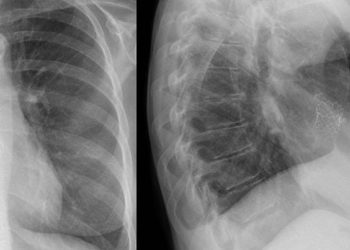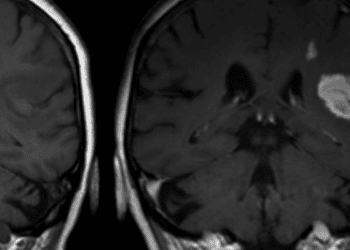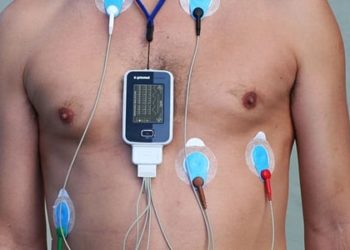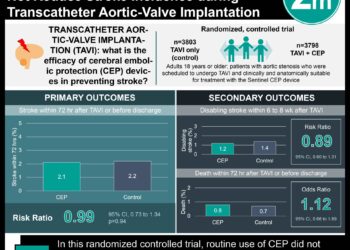No difference between noncontrast CT vs MRI for mechanical thrombectomy in patients with large vessel occlusion stroke
1. In patients with large-vessel occlusion stroke presenting within 6 to 24 hours, selection for mechanical thrombectomy by noncontrast computed tomography yielded no significant difference in clinical and safety outcomes compared with magnetic resonance imaging and computed tomography perfusion.
2. These findings suggested a potential expanded indication for treating patients with thrombectomy in the extended window of 6 to 24 hours, risk stratifying via noncontrast computed tomography imaging as an alternative to magnetic resonance imaging and computed tomography perfusion.
Evidence Rating Level: 2 (Good)
Study Rundown: Although recent landmark studies on the paradigm of care for patients with large-vessel occlusion stroke (DAWN and DEFUSE 3 trials) demonstrated the use of magnetic resonance imaging (MRI) and computed tomography perfusion (CTP) in triaging and selecting patients for mechanical thrombectomy, access to these advanced imaging techniques is not widely available. Instead, the workhorse for selecting patients presenting with stroke symptoms in the extended window for mechanical thrombectomy remains noncontrast computed tomography (NCCT) and CT angiography. This cohort study assessed the clinical outcomes in patients with proximal anterior circulation occlusion stroke presenting in the extended time window who were selected by NCCT and CT angiography, compared to those selected via CTP or MRI. The primary endpoint was the distribution of modified Rankin Scale (mRS) scores at 90 days (ordinal shift). Secondary endpoints included the rates of 90-day functional independence (mRS scores of 0-2), symptomatic intracranial hemorrhage, and 90-day mortality. Among 1,604 patients with large-vessel occlusion of the internal carotid artery and proximal middle cerebral artery (M1/M2 segments) undergoing mechanical thrombectomy, selection via NCCT had comparable clinical and safety outcomes to patients selected via advanced imaging with CTP or MRI in the extended window. These findings suggested a potential expanded indication for treatment with thrombectomy in the extended window, risk stratifying patients via NCCT imaging as an alternative to CTP or MRI. A limitation of this study was the interobserver variability in imaging interpretation between different physicians within and across multiple centers as well as in comparison to the automatic CTP processing software that could introduce bias.
Click to read the study in JAMA
Relevant Reading: Utilization and availability of advanced imaging in patients with acute ischemic stroke
In-Depth [retrospective cohort]: This multinational cohort study included 1,604 consecutive patients (median [IQR] age, 70 [59-80] years; 848 [52.9%] women) with proximal anterior circulation occlusion stroke presenting within 6 to 24 hours of time since last seen well. The study was conducted at 15 centers across 5 countries in Europe and North America from January 2014 to December 2020, with duration of follow-up at 90 days from stroke onset., CTP, or MRI. In patients that underwent mechanical thrombectomy, 534 were selected via computed tomography with the Alberta Stroke Program Early CT Score, 752 by CTP, and 318 by MRI. Overall, there was no significant difference in 90-day ordinal mRS shift between patients selected for mechanical thrombectomy via CT vs CTP (aOR, 0.95 [95%CI, 0.77-1.17]; P = .64) or CT vs MRI (aOR, 0.95 [95%CI, 0.8-1.13]; P = .55). The rates of 90-day functional independence (mRS scores 0-2 vs 3-6) were similar in patients selected by CT vs CTP (aOR, 0.90 [95%CI, 0.7-1.16]; P = .42) but lower in patients selected by MRI compared to CT (aOR, 0.79 [95%CI, 0.64-0.98]; P = .03). In addition, successful reperfusion was achieved more often in patients selected using CT and CTP compared to MRI (474 [88.9%] and 670 [89.5%] vs 250 [78.9%]; P < .001). For secondary outcomes, no significant differences were observed in symptomatic intracranial hemorrhage (CT, 42 [8.1%]; CTP, 43 [5.8%]; MRI, 15 [4.7%]; P = .11) or 90-day mortality (CT, 125 [23.4%]; CTP, 159 [21.1%]; MRI, 62 [19.5%]; P = .38).
Image: PD
©2021 2 Minute Medicine, Inc. All rights reserved. No works may be reproduced without expressed written consent from 2 Minute Medicine, Inc. Inquire about licensing here. No article should be construed as medical advice and is not intended as such by the authors or by 2 Minute Medicine, Inc.







